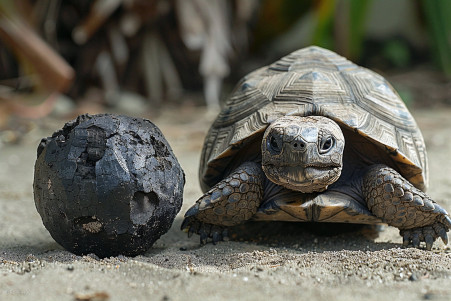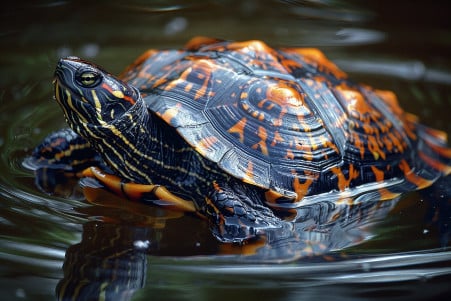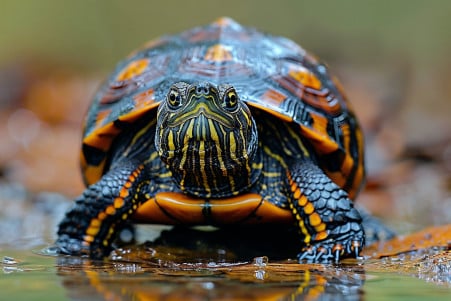The Rainbow of Turtles: What Do Their Colors Mean?
29 April 2024 • Updated 27 April 2024

Turtles have shells that range in color from green to brown, but have you ever thought about the specific colors of these amazing animals? Most turtles have shells that are olive, brown, reddish-brown, or black, and they have red, orange, or yellow on their skin and shells to help them blend in or to warn predators.
In this article, we will take a deep dive into the world of turtle coloration by looking at the scientific evidence behind the evolutionary pressures that have led to the development of their pigmentation and patterns. Drawing on research from the fields of evolutionary biology, ecology, and genetics, we will investigate how a turtle's coloration has evolved to help it survive in a variety of habitats. Not only will this information satisfy your curiosity, but it will also give you a greater understanding of the wonders of nature's adaptations.
What colors do turtle shells come in?
Camouflage and Survival: How the Color of Turtle Shells Helps Turtles Hide
Turtles have evolved incredible camouflage through their colorful shells that help them blend in with their surroundings. For example, the eastern box turtle's olive-green and brown shell with bright orange and yellow stripes helps it blend in with the leaf litter and forest floors. Meanwhile, the keeled box turtle's flat, solid-colored carapace with keels that stick up from the surface creates disruptive coloration that helps it blend in with substrates like deciduous leaves, a 2020 study on the Gabor edge disruption ratio of Asian box turtles found.
Sea turtles are also masters of camouflage. The hawksbill turtle's mottled shell in shades of amber, orange, red, yellow, black and brown helps it blend in with coral reefs and rocky coastal areas. This camouflage is especially important since turtles have many predators, including crocodiles, jaguars, and large sharks at various points in their lives. The color, pattern, and even the shape of their shells all help turtles avoid detection, giving them an evolutionary advantage.
The Biology and Evolution of Turtle Shell Coloration
The wide array of colors and patterns found on turtle shells is the product of a number of biological and evolutionary factors. According to Wikipedia, the turtle's shell is covered in keratinized scutes, which can be pigmented by cells like melanocytes and xanthophores.
The evolution of the turtle shell involved the modification of vertebrae and ribs, which can be seen in fossil ancestors like Eunotosaurus and Proganochelys, and may provide insight into how the shell evolved from broadened ribs. Meanwhile, genetic factors including the Pax1 and Sonic hedgehog genes have been shown to be involved in the development and patterning of the carapace and plastron, which has further influenced the range of turtle shell colors and patterns.
The arrangement and behavior of pigment cells and the deposition of pigments like carotenoids and pterins are among the factors that have contributed to the variety of colors and patterns seen in turtles, according to a paper that looked at the mechanisms of color production in archelosaurs. Together, these biological and evolutionary factors have led to the wide range of turtle shell colors and patterns that exist today.
Color Changes: How Turtle Shell Patterns Evolve With Age and Maturity
Turtle shell patterns and colors can change significantly as turtles age and mature. For example, baby turtles often have more colorful or vivid shells than adults, which can help them hide or warn off predators. A study on photo-dependent color development in eastern box turtles found that juvenile carapaces were mostly tan when raised in an indoor environment, but when the turtles were released into the wild, they developed the bright patterns that are characteristic of the species. The researchers concluded that the turtles needed direct sunlight to produce pigmentation in their carapaces.
Meanwhile, the carapace color of some turtles, such as the big-headed turtle, can change from a yellowish-brown to darker colors as the turtle grows older. However, while the growth rings on a turtle's plastron were once thought to be a reliable way to determine a turtle's age, it's now believed that they are more affected by things like diet and the availability of food, and are therefore not accurate age indicators, according to Reptiles Magazine.
By learning about the changes in turtle shell patterns and colors that occur as turtles grow and mature, we can gain a better understanding of the biological processes that determine these reptiles' appearances. This, in turn, can help us better appreciate the adaptations that turtles have made to survive in their habitats.
Sexual Dimorphism: Differences in Male and Female Turtle Shell Coloration
In many turtle species, there are noticeable differences in shell coloration between males and females, a phenomenon known as sexual dimorphism. As explained by The Spruce Pets, male turtles often have shells that are lighter or more colorful, which could be a way to attract mates. For example, male red-eared sliders have darker shells with more distinct red and yellow markings than females.
These differences in color may also be related to differences in shell morphology, with males tending to have flatter shells and larger cloacal openings that help them mate, as described in a Newswise article. Investigating the evolutionary basis of these differences in color between the sexes can help scientists better understand turtle mating systems and behaviors. From the most drab to the most colorful, the range of turtle shell colors shows just how adaptable these reptiles can be.
Nature's Artistry: The Aesthetics of Turtle Shell Coloration
In addition to their many other roles, the colors and patterns of turtle shells are a beautiful example of nature's artistry. Unusual and beautiful colorations, such as those seen in albino turtles, which can range from a creamy white to a bright yellow, are a clear example of the diversity that exists in turtle populations. Meanwhile, species like the ornate diamondback terrapin and the spotted pond turtle have shells with patterns that are works of art in their own right.
Recognizing the aesthetic appeal of turtle shell coloration can help people form a deeper connection to and appreciation of these fascinating animals. Meanwhile, learning about the biological mechanisms that lead to turtle shell coloration can help people better appreciate the complexity of nature and the wonders of evolution. The colors and patterns of turtle shells are a beautiful example of the complexity and artistry of the natural world.
Conclusion: Appreciating the Art of Nature
The wide range of colors and patterns seen on turtle shells are a product of the amazing adaptations and evolutionary processes that have shaped these reptiles. From camouflage and survival strategies to sexual dimorphism and visual cues, turtle coloration has many different roles in the wild.
Knowing the biological underpinnings and evolutionary pressures that have led to turtle shell coloration can help people better appreciate the complexity and art of nature. Turtles' bright, complex shell patterns are a testament to the creativity of evolution and an opportunity to appreciate the many marvels of the natural world.
By delving into the science of turtle coloration, we can learn more about these fascinating animals and the places they call home.


